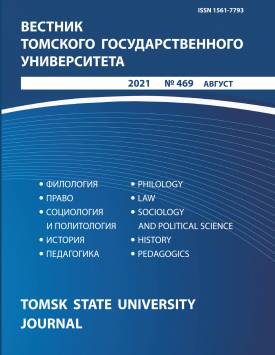Metaphors of Childhood in Contemporary American Discourses
The article examines metaphors of childhood and growing up that are used by native speakers of American English. To analyse the metaphors used in the conversational discourse of childhood, a survey on the online platform Survey Monkey was conducted. Both individual answers of the respondents and general tendencies in the verbalization of the phenomena are considered. The body of the article includes a description of the experiment and an analysis of its results. The aim of this study is to identify the main trends in the verbalization of the experience of childhood and growing up, as well as the possibility of modifying conventional metaphors and creating individual metaphorical projections. The article is based on two important lines of linguistic research: discourse and discourse metaphor. A significant role in the formation of perception of a certain phenomenon is played by the dynamic processes of linguistic activity that have developed in a certain social context, that is, discourses. Chronological parameters, dividing age into periods are social constructs, and discursiveness is a way of linguistic construction of this phenomenon. Discourse metaphor is a relatively stable metaphorical projection that functions as a key framing tool within a certain discourse during a certain period of time. Metaphor acts as a means of conveying the author's ideas, as well as a unit of text formation, contributing to the structuring and categorisation of the real world. Thus, metaphor is a way of verbalising subjective reality, which allows structuring personal experience. Based on the study, a number of general conclusions can be drawn. 1. Most of the answers that reflect the perception of childhood are emotionally coloured and carry positive or negative judgments. Within the same answer, there are directly opposite formulations, which indicates the ambiguity and contradictions of the subjective experience of childhood. 2. Despite the control by society, the experience of childhood and growing up is a phenomenon of subjective reality. 3. In addition to the explicit way of verbalising childhood, one of the main tools for conceptualising this experience among the representatives of modern American linguistic culture is metaphor. 4. There is a heterogeneity of the metaphors used. Representatives of American culture both adapt the already existing conventional metaphors and create individual metaphors. As a result, their combination forms a unique metaphorical landscape.
Keywords
English-language culture,
conversational discourse,
discourses of childhood and growing up,
metaphor,
metaphorical creativity,
metaphorical landscapeAuthors
| Korshunova Aleksandra I. | Higher School of Economics | alexandra.korshunova.96@gmail.com |
Всего: 1
References
Коршунова А.И. Дискурсивное конструирование феномена «детство» в англоязычной культуре // Человек: Образ и сущность. 2020. № 2 (42). С. 21-39.
Нефедова Л.К. Феномен детства в основных формах его репрезентации (философия, миф, фольклор, литература) : автореф. дис.. д-ра филос. наук. Омск, 2005.
Evans S., Garner J. Talking over the years: A handbook of dynamic psychotherapy with older adults. New York : Routledge, 2004. 304 p.
Нагорная А.В. Дискурсивное конструирование феноменов старости и старения: опыт англоязычных стран // Межкультурная коммуника ция в эпоху глобализации: свое, чужое, универсальное. М. : ИНИОН РАН, 2019. С. 77-88.
Zinken J., Hellsten I., Nerlich B. Discourse metaphors // Body, Language and Mind. 2008. Vol. 2: Sociocultural Situatedness. P. 363-385.
Нагорная А.В. Дискурс невыразимого: Вербалика внутрителесных ощущений. М. : ЛЕНАНД, 2014. 320 c.
Нагорная А.В. Метафоры старения и старости в обиходно-разговорных дискурсах современной Америки // Вестник Томского государ ственного университета. Филология. 2021. № 69. C. 142-165. DOI: 10.17223/19986645/69/7.
Gentner D., Colhoun J. Analogical Processes in Human Thinking and Learning // Towards a Theory of Thinking: Building Blocks for a Conceptual Framework. Berlin : Springer, 2010. P. 35-48.
Bowdle B.F., Gentner D. The Career of Metaphor // Psychological Review. 2005. Vol. 112, № 1. P. 193-216.
Pragglejaz Group. MIP: A method for identifying metaphorically used words in discourse // Metaphor and symbol. London : Lawrence Erlbaum Associates, 2007. P. 1-39.
Lawley J., Tompkins P. Metaphors in Mind: Transformation Through Symbolic Modelling. London : Crown House Pub., 2000. 226 p.
Bunge M. The Child in Christian Thought. Grand Rapid : Wm. B. Eerdmans-Lightning Source, 2001. 527 p.
Бабарыкина Т.С. Характеристика английского концепта child на основе словарных дефиниций // Вестник Северного (Арктического) федерального университета. Серия: Гуманитарные и социальные науки. 2009. № 4. С. 57-61.
Lumsden K. Boy Racer Culture: Youth, Masculinity and Deviance. New York : Routledge, 2013. 208 p.
Beales R.W. In Search of the Historical Child: Miniature Adulthood and Youth in Colonial New England // American Quarterly. 1975. Vol. 27, № 4. P. 379-398.
Bayliss S. Innocent or Not So? The Shifting Visions of Childhood // The New York Times. 1999. URL: https://www.nytimes.com/1999/03/14/arts/art-artchitecture-innocent-or-not-so-the-shifting-visions-of-childhood.html (дата обращения: 06.01.2021).
Family and Parenting Institute. Is It Legal? A Parents' Guide to the Law. URL: https://www.rbkc.gov.uk/pdf/FPI%20is%20it%20legal%20Feb_08.pdf (дата обращения 20.01.2021).
Dubois L. Superheroes and «the American Way»: Popular Culture, National Identity, and American Notions of Heroism and Leadership. Richmond University. URL: https://scholarship.richmond.edu/cgi/viewcontent.cgi?article=2397&context=honors-theses (дата обращения: 20.12.2020)
Diamond in the rough // Электронный словарь Merriam Webster. URL: https://www.merriamwebster.com/dictionary/diamond%20in%20the%20rough (дата обращения: 15.12.2020).
Aries P. Centuries of Childhood: A Social History of Family. New York : Random House, 1965. 448 p.
Lehner E., Lehner J. Folklore and Symbolism of Flowers, Plants and Trees. New York : Dover Publications, 2003. 128 p.
Columbia News Service. Parenting Goes Gender Neutral // Columbia News Service. 2011. URL: https://columbianewsservice.com/ 2011/04/parenting-goes-gender-neutral/(дата обращения: 20.01.2021).
UNICEF. Early Childhood Early Gender Socialization, 2007. URL: https://www.unicef.org/earlychildhood/index_40749.html (дата обращения: 23.01.2021).
Dragseth J. Thinking Woman: A Philosophical Approach to the Quandary of Gender. Cambridge : Lutterworth Press, 2016. 214 p.
Boys will be boys // Электронный словарь Merriam Webster. URL: https://www.merriam-webster.com/dictionary/boys%20will%20be%20boys (дата обращения: 15.12.2021).
Columbia News Service. Boys Will Be Boys. Unless They're Girls // Columbia News Service. 2011. URL: https://columbianewsservice.com/ 2011/04/parenting-goes-gender-neutral/(дата обращения: 20.01.2021).
Blake B.J. English Vocabulary Today: Into the 21st Century. New York : Routledge, 2019. 192 p.
Theyby // Электронный словарь Macmillan English Dictionary for Advanced Learners. URL: https://www.macmillandictionary.com/diction-ary/british/theyby (дата обращения: 15.12.2020).

